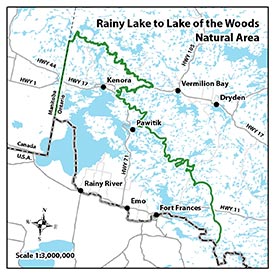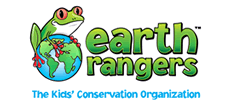Rainy Lake to Lake of the Woods
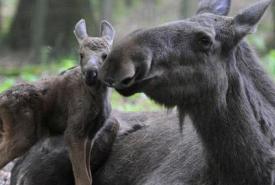
Moose and her calf (Photo courtesy of Wild for Wildlife and Nature)
Why this place is important
The Rainy Lake to Lake of the Woods Natural Area is one of Ontario’s largest natural areas. Located in the extreme western part of Ontario, it straddles the Manitoba border and stretches from Lake of the Woods, north of the Rainy River, to Rainy Lake. Its 1,994,352 hectares (4,928,152 acres) are comprised of boreal and hardwood forests, western prairie and extensive lakes and wetlands.
Rainy Lake to Lake of the Woods is at the convergence of three distinct ecoregions: Lake Wabigoon in the east, Lake of the Woods (Manitoba) in the west and the Agassiz Clay Plain in the south. This mixture of habitats supports unique and globally rare plants, such as rams-head lady’s-slipper, and animals, such as piping plover.
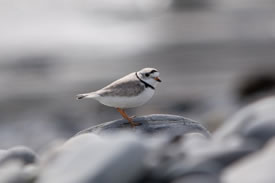
Piping plover (Photo by Andrea Drake)
Unlike many areas of Ontario’s North that belong to boreal forests — areas of relatively low, but still important biodiversity — the Rainy Lake to Lake of the Woods Natural Area abounds with wildlife, including more than 500 species of plants. The area is also home to many freshwater islands, which provide important habitat for colonial nesting birds, waterfowl and migratory birds.
What NCC is doing

Sunset, Town Island, Kenora, ON (Photo by Patty Nelson)
The Nature Conservancy of Canada (NCC) has been working to conserve land in the Rainy Lake to Lake of the Woods Natural Area since 1997, and currently protects just over 321 hectares (793 acres) here. NCC has targeted our conservation efforts on the area’s unique island habitats and forest communities. Less than 10 per cent of this vast natural area is currently under conservation protection.
Since 2014, NCC has participated in the LakeSmart Program run by our partner, the Lake of the Woods District Stewardship Association. The LakeSmart Program is an outreach program promoting environmental stewardship on Lake of the Woods.
What lives there
These are some of the significant and at-risk species found in this natural area:
Reptiles, amphibians and turtles
- northern leopard frog
- snapping turtle
- Birds
- American white pelican
- bald eagle
- bank swallow
- barn swallow
- black tern
- bobolink
- Canada warbler
- Caspian tern
- chimney swift
- common nighthawk
- eastern meadowlark
- eastern whip-poor-will
- eastern wood-pewee
- evening grosbeak
- golden eagle
- golden-winged warbler
- least bittern
- olive-sided flycatcher
- peregrine falcon
- piping plover
- red-headed woodpecker
- red-necked grebe
- rough-legged hawk
- rusty blackbird
- semipalmated sandpiper
- short-eared owl
- western meadowlark
- wood thrush
- yellow rail
Fish
- lake sturgeon
Invertebrates (insects, arachnids, mussels and snails)
- monarch
- mottled duskywing
Mammals
- American badger
- black bear
- elk
- gray fox
- gray wolf
- moose
Plants
- brittle prickly-pear cactus
- dwarf bulrush
- eastern white pine
- northern pin oak
- ram's-head lady's-slipper
- red pine
Threats
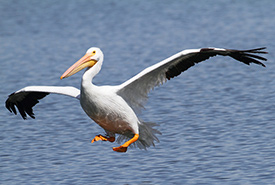
American white pelican (Photo by Bill Hubick)
Contaminants, excess nutrients and algae blooms threaten both Lake of the Woods and Rainy Lake, as well as the many smaller lakes found within this vast natural area. Invasive species, such as phragmites and narrow-leaved cattail, are becoming established in area wetlands and shorelines, posing a real threat to native plants.
As the demand for second homes increases, the rare and fragile ecosystems of the islands and shoreline are at risk from the development of cottages. Inland, expanding agriculture is also threatening wetlands through land clearing and drainage.
History
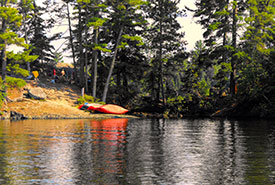
Campers, Town Island, Kenora, ON (Photo by Patty Nelson)
Indigenous Peoples have called the Rainy Lake to Lake of the Woods Natural Area home for millennia. The area is entirely within the territory of Grand Council Treaty No. 3 and is home to 22 First Nations. During the fur trade, Rainy Lake and Lake of the Woods were at the centre of a thriving trade network by Indigenous Peoples. Today, tourism, mining and forestry dominate the area’s economy.
The area has also been a treasured destination for seasonal cottage owners for generations and has hosted summer camps for more than a century.
Partners
The protection of the Rainy Lake to Lake of the Woods Natural Area is not something we can achieve on our own. Only through strong partnerships can this unique area continue to grow and thrive. NCC thanks the following partners for their generous support of our ongoing efforts in this natural area:
- Rainy Lake Conservancy
- Lake of the Woods District Stewardship Association
- And many private donors and landowners.
Current projects
Click here to learn more about our current projects in the Rainy Lake to Lake of the Woods Natural Area


